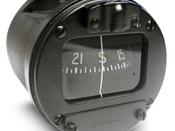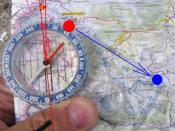The compass is an instrument containing a freely suspended magnetic element which displays the direction of the horizontal component of the Earth's magnetic field at the point of observation. The magnetic compass is an old Chinese invention. Chinese fortune tellers used lodestones to construct their fortune telling boards. Magnetite was nicknamed lodestone and used by early navigators to locate the magnetic North Pole.
Eventually someone noticed that the lodestones were better at pointing out real directions, leading to the first compasses. They designed the compass on a square slab which had markings for the cardinal points and the constellations. The pointing needle was a lodestone spoon-shaped device, with a handle that would always point south. Magnetized needles used as direction pointers instead of the spoon-shaped lodestones appeared in the 8th century AD, again in China, and between 850 and 1050 they seem to have become common as navigational devices on ships.
The first person recorded to have used the compass as a navigational aid was Zheng He (1371-1435), from the Yunnan province in China, who made seven ocean voyages between 1405 and 1433.
As found in the Encyclopedia Britannica, 1999 "Sometime in the 12th century, mariners in China and Europe made the discovery, apparently independently, that a piece of lodestone, a naturally occurring magnetic ore, when floated on a stick in water, tends to align itself so as to point in the direction of the polestar. This discovery was presumably quickly followed by a second, that an iron or steel needle touched by a lodestone for long enough also tends to align itself in a north-south direction." and further that the "Chinese were using the magnetic compass around AD 1100, western Europeans by 1187, Arabs by 1220, and Scandinavians by 1300." Some speculate that in 101 BCE Chinese...


